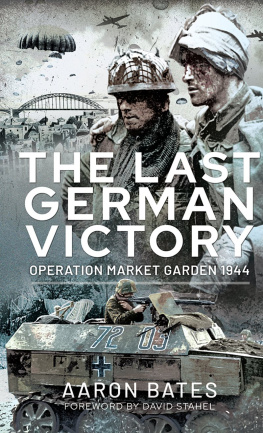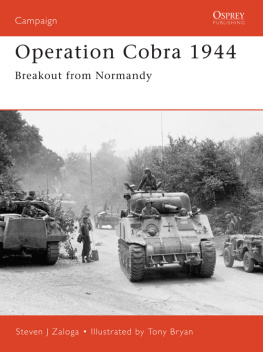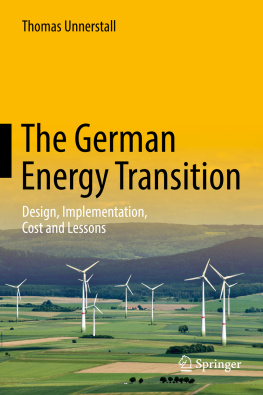1988 The University of North Carolina Press
All rights reserved
Manufactured in the United States of America
The paper in this book meets the guidelines for permanence and durability of the Committee on Production Guidelines for Book Longevity of the Council on Library Resources.
95 94 93 5 4 3 2
Library of Congress Cataloging-in-Publication Data
Mierzejewski, Alfred C.
The collapse of the German war economy, 19441945: Allied air power and the German national railway / by Alfred C. Mierzejewski.
p. cm.
Bibliography: p.
Includes index.
ISBN 0-8078-1792-9 (alk. paper)
1. GermanyEconomic conditions1918-1945. 2. Bombing, Aerial GermanyHistory. 3. TransportationGermanyHistory20th century. 4. Deutsche Reichsbahn (Germany)History20th century. 5. Railroad and stateGermanyHistory20th century. 6. Germany Strategic aspects. I. Title.
HC 286.4.M45 1988 884777
330.943087dci9 CIP
THIS BOOK WAS DIGITALLY MANUFACTURED .
The Collapse of the German War Economy, 19441945
Wheels Must Roll for Victory! (Vlkischer Beobachter, 1 July 1942)
Contents
Tables
1.1. Index of Labor Productivity in the Armaments Industry, 19411944 /
1.2. Examples of Increases in Armaments Production, 19401944 /
3.1. Comparison of German Railroad Performance in World Wars I and II /
4.1. Comparative Economic Power of the Warring States in Europe, 1943 /
7.1. United Steels Situation, Fourth Quarter 1943-Fourth Quarter 1944 /
A.1. German Hard Coal Production /
A.2. German Brown Coal Production /
A.3. Reichsbahn Freight Car Placings /
A.4. Reichsbahn Hard Coal Car Placings /
A.5. Inland Waterway Coal Movements, Hard and Brown Coal Combined /
A.6. Estimated Hard Coal Deficit Caused by Shipping Difficulties /
A.7. Reichsbahn Freight Car Placing Comparison /
A.8. The GBLs and Their Directorates /
A.9. Reichsbahn Coal Car Placing Targets, 24 May 1944 /
A.10. Germanys Coal Syndicates /
A.11. Syndicate Trading Companies of the RWKS /
Figures and Maps
Figures
1.1. Percentage Change in the Index of Armaments Production., 19421945 /
A.1. Armaments Production and Railroad Performance, 19431945 /
Maps
2.1. Germanys Economic Areas /
3.1. Deutsche Reichsbahn Directorates /
3.2. Main Freight Arteries of the Deutsche Reichsbahn /
3.3. RED Essen and the Coal Gateways /
3.4. Germanys Inland Waterways /
Preface
The following work is an account of the collapse of the German economy in 19441945. It examines how the intricate economic system created by the Germans after the mid-nineteenth century and refined for war purposes by Albert Speer crumbled due to the paralysis of its transportation system. The German transportation net and especially the German National Railway, the Deutsche Reichsbahn, was subjected to a violent bombing campaign by the American and British strategic air forces beginning in September 1944. Within four months the exchange of vital commodities in the Reich economy, especially coal, had broken down and every form of industrial production was in decline or had ground to a halt. How this happened, and how the Allies came to conduct this devastating campaign is portrayed in detail.
Until recently the economic history of the Third Reich has been comparatively neglected. Among the works that have appeared during the last few years none has focused on the operation of the German economy during World War II. A chronological account is given because no thematic rendering can fully portray the sequence of events and the chaos that swept Germany beginning in September 1944 and the interaction between the leaders of the German economy and their assailants. It is hoped that an anatomy of the collapse of a highly developed industrial economy is the result. This may illuminate how complex organizations, in this case the Deutsche Reichsbahn and the Speer ministry, attempted to cope with massive external challenges. It should also provide a warning to those who, even in this nuclear age, lightly contemplate future conventional air offensives.
Three analytical themes shape the present work. Because of their importance and the novelty of their application they bear elucidation at the outset.
The first crucial consideration holds that the German industrial economy had been shaped decades before the Nazi seizure of power by a geographical and functional division of labor based on proximity to and exploitation of the nations coal supplies. A large and highly ramified transportation system enabled the division of labor to function effectively, permitting coal to flow to consumers far removed from the mines and manufactured goods and food to be exchanged among economic regions. The transportation system itself relied on coal for energy, and the prime mover of coal was the systems largest component, the national railroad, the Deutsche Reichsbahn. The Reichsbahn was an extensive network that connected the raw material base of the German industrial pyramid to the administrative pinnacle, the military consumer of armaments, and every intermediary level. The marshalling yard was its heart. Here the division of labor found physical expression. Here the Reichsbahn gathered its strength. Here movement on the entire rail net was controlled. But the marshalling yard was also its Achilles heel. These yards were vulnerable to a host of forms of delay and disruption, which would rapidly reverberate throughout the railroad and the economy if unchecked. Moreover, a few marshalling yards closely associated with the division of labor set the pace for the entire mechanism. They were of overriding importance and the Reichsbahn made extensive provision to shield them from the vicissitudes of war.
The second leading idea is that working within the constraints set by the division of labor and Nazi economic ideas, Albert Speer imposed a system of industrial efficiency that enabled Germany vastly to increase its armaments production after February 1942. The ideological and political obstacles confronting Speer were more complex than has frequently been recognized. They did not consist of a set of coherent plans characterized as Blitzkrieg economics, as has recently been made clear. The Nazis did indeed divert a considerable proportion of national resources to rearmament. But two crucial factors prevented them from reaping the full return on their investment. First, their efforts were hamstrung by their own gross inefficiency born of haste and internally contradictory ideological imperatives. Secondly, their buildup did not correspond with the foreseeable ultimate proportions of the war that they hoped to ignite. There can be no doubt that the Nazis sought to adapt then current ideas of mechanized warfare to the Moltkean strategic tradition of quick victory. They hoped to avoid another prolonged attritional contest similar to World War I. They sought short though not necessarily small wars. This is an important consideration when weighing Nazi economic mobilization and the Reichsbahns place in it. The scale of measurement must be the effort made by Germany during World War I, not current standards. Speer and his cohorts in his ministry and the Reichsbahn worked in that intellectual environment, not our late twentieth-century one. Fie articulated a response that was uniquely suited to it. The keys to Speers reforms were the improvement of production practices through his revitalization of the network of rings and committees, his careful effort to obtain and preserve the explicit support of Hitler for his policies, and his creation of a centralized apparatus for the establishment of priorities and the evaluation of economic data that allowed him to orchestrate the whole as a system. Speers edifice was very carefully balanced and its emphasis on the highest efficiency placed a great burden on the Reichsbahn.









